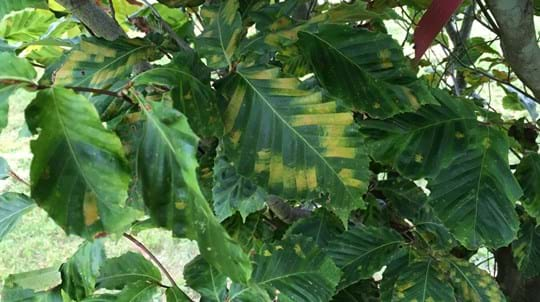
Pests and diseases
Beech Leaf Disease
Beech leaf disease is a newly described disease causing discolouration of beech leaves.

Fera Science Ltd
A new disease of beech trees (Fagus spp.) named ‘Beech leaf disease’ (BLD) is spreading through forest areas in eastern USA and Canada. The disease was first reported on American beech in Ohio and rapidly spread to forest and landscaped areas in neighbouring regions. A nematode (Litylenchus crenatae mccannii) has been isolated from the symptomatic leaves and buds. To date, there have been no reports of BLD in the UK.
It was first identified as a risk to Europe in 2019 and lead to its addition to the UK Plant Health Risk Register. The risk posed by organisms are rated on a scale from 1 to 125; and BLD was given an overall risk rating of 75 demonstrating the U.K.’s concern and the need for greater surveillance. Contact with Dr Carrie Ewing, Ohio State University confirmed its suitability for citizen science surveillance with Observatree - ‘The symptoms are very diagnostic. From my extensive research, we don’t really find anything that looks quite like either the banding or the crinkling symptoms’.
It’s not only Observatree and the UK Plant Health Service that recognised the threat but also European nematologists. A new EUPHRESCO project called FAGUSTAT is being led by Dr Nicole Viaene from Belgium. Dr Tom Prior, Senior nematologist at Fera is not only carrying out scientific research and contributing to the FAGUSTAT project, but has been working with Observatree to help raise public awareness by leading on the collation of the new BLD Field Identification Guide.
Nematodes are very small microscopic ‘worm-like’ animals, sometimes called roundworms, and in plant science referred to as ‘eelworms’. In general, most nematodes are harmless and are an important part of good soil health helping to breakdown organic matter. However, others can be harmful to plant health - these plant parasitic nematodes range in size from ¼ mm to 3mm so cannot be easily seen by the naked eye. Almost all plant pathogenic nematodes live part of their lives in the soil and may feed on surfaces (ectoparasites) or enter the host and feed from within (endoparasites). During feeding, they secrete saliva containing enzymes to help obtain their nutrients, which the host reacts to resulting in damage. This can cause root lesions (brown dead patches), knots and galls (excessive host cell growth) or root branching all of which cause visible symptoms. These is turn can lead to a loss of vigour and above ground symptoms such as stunting and yellowing similar with nutrient deficiency symptoms. Nematodes may also feed in above ground parts and there are several species that can affect buds and foliage such as Litylenchus nematodes that induce BLD.
Hosts
BLD is mainly known to affect American beech (Fagus grandifolia). However, symptoms have been observed on European beech (F. sylvatica) and oriental beech (F. orientalis).
Symptoms
These include dark bands forming between the veins of leaves; the leaves becoming curled, deformed and shrivelled; as well as premature leaf drop; aborted buds; and thinning canopy. Early symptoms include dark-green striped bands between lateral leaf veins and reduced leaf size. Banded areas usually become ‘leathery’ and leaf curling may be observed. Similar symptoms may be caused by other native pests and pathogens (such as leaf miners and mites) which are illustrated in the Observatree Field Identification Guide.
Spread
The disease is spread both long distances and locally by infested plants, windborne infested plant material (leaves/ shoots) and leaf-litter/soil infested with nematodes.
Reporting
This is a notifiable pest so if you find it you must report it. Please report through TreeAlert.
In Northern Ireland, please report via the TreeCheck website or phone app, or by emailing planthealth@daera-ni.gov.uk.